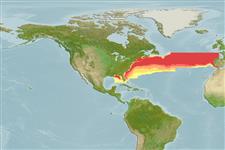Common names from other countries
Environment: milieu / climate zone / depth range / distribution range
Écologie
marin. Temperate; 48°N - 24°N, 89°W - 5°W
Western Atlantic: Nova Scotia in Canada to southern Florida in USA and eastern Gulf of Mexico (Ref. 7251). Eastern Atlantic: juveniles occasionally accompany floating objects across the Atlantic and have been recorded from Ireland, around the British Isles, off Portugal and the western Mediterranean.
Taille / Poids / Âge
Maturity: Lm ? range ? - ? cm
Max length : 91.0 cm TL mâle / non sexé; (Ref. 7251); common length : 30.0 cm SL mâle / non sexé; (Ref. 4542); poids max. publié: 12.3 kg (Ref. 7251)
Lives in deep water over continental slopes. Adults in submarine canyons, young more widely found in surface layers and may occur at times close inshore docks. Young to 30 cm common in large groups during summer and autumn under floating boards, boxes and barrels. Does not associate with medusae. Adults probably schooling in depths but not on the bottom. Feed on small fishes and crustaceans; also sqiud and molluscs (Ref. 5951). Probably a spring spawner. (see Ref 4542).
Life cycle and mating behavior
Maturities | Reproduction | Spawnings | Egg(s) | Fecundities | Larves
Bauchot, M.-L., 1987. Poissons osseux. p. 891-1421. In W. Fischer, M.L. Bauchot and M. Schneider (eds.) Fiches FAO d'identification pour les besoins de la pêche. (rev. 1). Méditerranée et mer Noire. Zone de pêche 37. Vol. II. Commission des Communautés Européennes and FAO, Rome. (Ref. 3397)
Statut dans la liste rouge de l'IUCN (Ref. 130435)
CITES (Ref. 128078)
Not Evaluated
Menace pour l'homme
Harmless
Utilisations par l'homme
Pêcheries: intérêt commercial mineur
Outils
Articles particuliers
Télécharger en XML
Sources Internet
Estimates based on models
Preferred temperature (Ref.
115969): 5.7 - 19.7, mean 11.6 (based on 85 cells).
Phylogenetic diversity index (Ref.
82804): PD
50 = 0.5156 [Uniqueness, from 0.5 = low to 2.0 = high].
Bayesian length-weight: a=0.00891 (0.00406 - 0.01955), b=3.10 (2.91 - 3.29), in cm Total Length, based on LWR estimates for this (Sub)family-body shape (Ref.
93245).
Niveau trophique (Ref.
69278): 3.9 ±0.55 se; based on food items.
Résilience (Ref.
120179): Faible, temps minimum de doublement de population : 4,5 à 14 années (Preliminary K or Fecundity.).
Fishing Vulnerability (Ref.
59153): High vulnerability (56 of 100).
